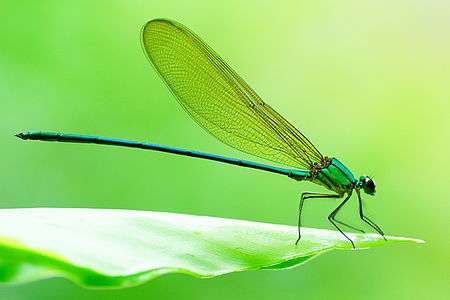Vestalis gracilis
| Clear-winged forest glory | |
|---|---|
 | |
| Male | |
.jpg) | |
| Female | |
| Scientific classification | |
| Kingdom: | Animalia |
| Phylum: | Arthropoda |
| Class: | Insecta |
| Order: | Odonata |
| Suborder: | Zygoptera |
| Family: | Calopterygidae |
| Genus: | Vestalis |
| Species: | V. gracilis |
| Binomial name | |
| Vestalis gracilis Rambur, 1842 | |
Vestalis gracilis,[2][3] is a species of damselfly belonging to the family Calopterygidae. It is known commonly as the clear-winged forest glory[4][5] or clear-winged flash-wing.[4] It is native to Southeast Asia and surrounding regions.[1][6]
Description
The male and female are similar in size; the male having an abdomen 45 to 46 millimeters long and a hindwing 34 to 38 millimeters long and the female with an abdomen 43 to 50 millimeters long and a hindwing 36 to 39 millimeters long.[7][8][9][4][5]
The male is iridescent green with a yellow and black underside. It has brown legs and blue-tinged transparent wings. The eyes are dark brown above and greenish yellow below. The female is duller greenish brown in color.[7][8][4]
Habitat
This is a common species across much of its range. It breeds in forest streams, often in disturbed and cultivated areas too.[1] Commonly seen as a group rest among bushes in forest paths and shades together with Vestalis apicalis.[7][8][4]
Subspecies
A subspecies, V. g. montana Fraser, 1934, has been described from Western Ghats of South India.[1] It is now synonymised with V. a. submontana and is considered as a separate species Vestalis submontana.[2][10][3]
See also
References
- 1 2 3 4 Dow, R.A. (2009). "Vestalis gracilis". IUCN Red List of Threatened Species. IUCN. 2009: e.T163667A5632782. doi:10.2305/IUCN.UK.2009-2.RLTS.T163667A5632782.en. Retrieved 20 February 2017.
- 1 2 Martin Schorr; Dennis Paulson. "World Odonata List". University of Puget Sound. Retrieved 12 Oct 2018.
- 1 2 M. Hamalainen. "Calopterygoidea of the World" (PDF). caloptera.com. Retrieved 2017-02-20.
- 1 2 3 4 5 "Vestalis gracilis Rambur, 1842". India Biodiversity Portal. Retrieved 2017-02-20.
- 1 2 "Vestalis gracilis Rambur, 1842". Odonata of India, v. 1.00. Indian Foundation for Butterflies. Retrieved 2017-02-20.
- ↑ K.A., Subramanian; K.G., Emiliyamma; R., Babu; C., Radhakrishnan; S.S., Talmale (2018). Atlas of Odonata (Insecta) of the Western Ghats, India. Zoological Survey of India. pp. 70–71. ISBN 9788181714954.
- 1 2 3 Subramanian, K. A. (2005). Dragonflies and Damselflies of Peninsular India - A Field Guide.
- 1 2 3 C FC Lt. Fraser (1934). The Fauna of British India, including Ceylon and Burma, Odonata Vol. II. Red Lion Court, Fleet Street, London: Taylor and Francis. pp. 126–130.
- ↑ C FC Lt. Fraser (1924). A Survey of the Odonate (Dragonfly) Fauna of Western India and Descriptions of Thirty New Species (PDF). p. 479.
- ↑ M. Hamalainen. "NOTES ON THE TAXONOMIC STATUS OF VESTALIS SUBMONTANA ERASER, 1934 FROM SOUTH INDIA (ZYGOPTERA: CALOPTERYGIDAE)" (PDF). caloptera.com. Retrieved 2017-02-20.
External links
![]()
![]()
